Falcon Northwest FragBox SLI: Dare to Dream
by Jarred Walton on May 3, 2006 9:00 AM EST- Posted in
- Systems
Synthetic Gaming
While some might argue otherwise, we really have trouble qualifying Futuremark's 3DMark applications as anything but synthetic benchmarks. They basically represent another potential 3D gaming engine, but unlike actual games, the engine is not used for anything in the real world. That doesn't make them useless, and they do provide yet another gauge of overall system performance. However, given the choice between 10% higher 3DMark scores and 10% higher scores in a real game, the latter would get our overwhelming vote.
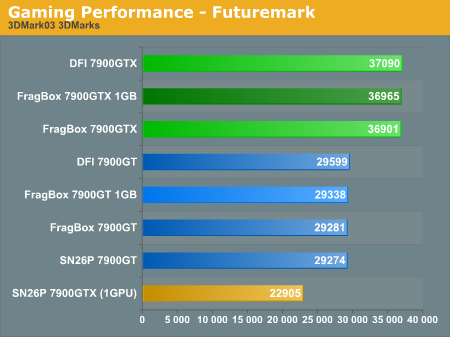

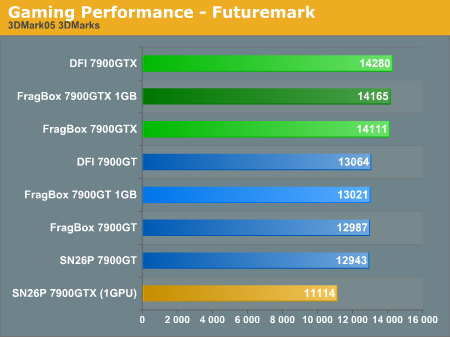
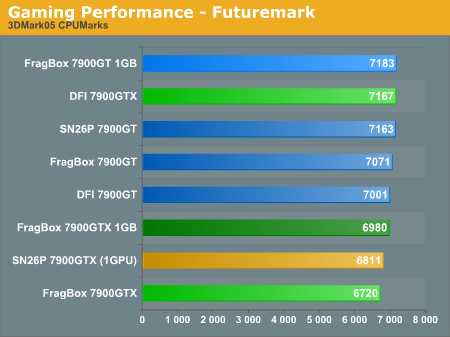

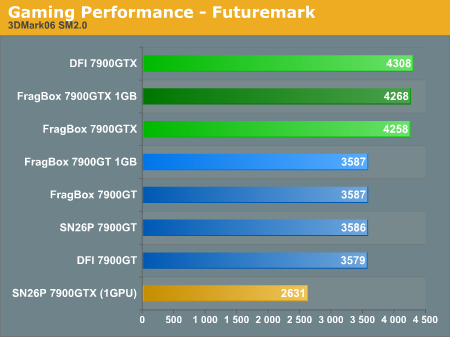
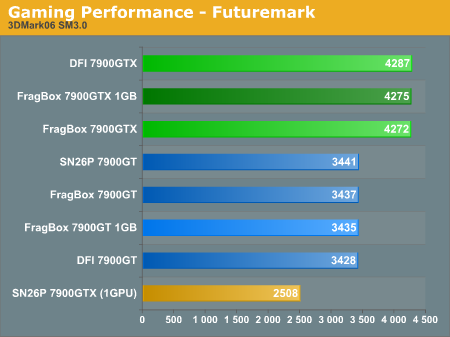

Our DFI system comes out on top by small margins in virtually every configuration, but there's nothing that we would really consider significant. Unlike PCMark, 3DMark depends almost exclusively on graphics card performance, and to a lesser degree on CPU performance. The CPU scores naturally focus more on that area, and the FragBox lags behind slightly in 3DMark03 CPU scores. In other tests, the tighter memory timings of the 1GB setup moves that configuration to the top of the charts. An odd twist is that the FragBox with the 7900 GT performs better in the CPU test of 3DMark05 than with the 7900 GTX; we are not entirely sure why that occurs, and we wouldn't place too much significance on it. These are synthetic benchmarks, and the end result is that we've once again basically got a tie.
While some might argue otherwise, we really have trouble qualifying Futuremark's 3DMark applications as anything but synthetic benchmarks. They basically represent another potential 3D gaming engine, but unlike actual games, the engine is not used for anything in the real world. That doesn't make them useless, and they do provide yet another gauge of overall system performance. However, given the choice between 10% higher 3DMark scores and 10% higher scores in a real game, the latter would get our overwhelming vote.








Our DFI system comes out on top by small margins in virtually every configuration, but there's nothing that we would really consider significant. Unlike PCMark, 3DMark depends almost exclusively on graphics card performance, and to a lesser degree on CPU performance. The CPU scores naturally focus more on that area, and the FragBox lags behind slightly in 3DMark03 CPU scores. In other tests, the tighter memory timings of the 1GB setup moves that configuration to the top of the charts. An odd twist is that the FragBox with the 7900 GT performs better in the CPU test of 3DMark05 than with the 7900 GTX; we are not entirely sure why that occurs, and we wouldn't place too much significance on it. These are synthetic benchmarks, and the end result is that we've once again basically got a tie.










32 Comments
View All Comments
poohbear - Thursday, May 4, 2006 - link
maybe it's just me, but a big part of my computer hobby is actually putting it together and fine tuning all the components myself. if someone else put it all together for me, it'd ruin the fun portion for me.:/PeteRoy - Thursday, May 4, 2006 - link
Daquing Oilfields is the most graphic and memory intesive map in Battlefield 2, it also has the most vehicles in the game.Next time, make a demo for Battlefield 2 using the daquing oilfields map.
AaronAxvig - Thursday, May 4, 2006 - link
I was under the impression that the harddrives were still a bottleneck at times. Why are 15k SCSI drives never used. Surely two of them and a controller wouldn't put the price over $10,000. And there are a few that would pay that much out there somewhere.2x 147GB 15k Maxtors: $2000
1x Controller Card: $200
And those are rounded up prices.
fatpipes - Thursday, May 4, 2006 - link
15K drives are not very nice for home use. Loud, lots of vibration, shorter lifespan, smaller capacity. A raid array is much nicer for this purpose. 15K drives are almost exclusively SCSI (haven't seen a SATA one yet), which would be essentially impossible for this form-factor and purpose. You would need a board with integrated SCSI, which is not available on any nForce4 boards. Or you would need to drop a video card to free up a PCI slot for a SCSI card.fatpipes - Thursday, May 4, 2006 - link
Basically, you'll be forgoing SLI for SCSI either way (either non-nForce4 with integrated SCSI or nForce4 with a SCSI card). In the tower chassis, this is possible, but still not very sensible compared to SATA RAID.phusg - Thursday, May 4, 2006 - link
Yeah there are a few, and after receiving their PC with 15k HDDs they will realise that the Raptors are silent by comparison and send the box back complaining about the high pitched whine...CrystalBay - Thursday, May 4, 2006 - link
Thanks, that was fun...fatpipes - Wednesday, May 3, 2006 - link
The CPU heat sink fan is _directly_ below the PSU bottom-intake fan. There's just one problem... the CPU fan pulls air DOWN into the fins while the PSU fan pulls air UP into its enclosure. This is worthless for CPU cooling! They'd be better off with a tall passive heat sink.The hard drives could use some shock mounts with a fan bolted directly to the metal frame of the drive cage.
However, their cooling strategy for the GPUs is novel, especially in such a tight space.
Forgive me for being highly critical of SFF PCs, the pressure zones in this case have to be very messy. It looks to me like the airflow moves in a downward spiral starting at the GPU cooler fan and coming out from the back of the power supply after looping over the hard drives and the "front-top" of the motherboard.
However, a warning about placing a positive and a negative fan side-by-side (PSU output, GPU input, 1" apart), they can actually recycle each others' air lowering the efficiency of the fan. You can even see this if you have a single high-speed fan, it actually recycles some of its own air if it isn't enclosed for at least an inch to each side of the opening.
High performance computers don't belong in a box that small.
JarredWalton - Wednesday, May 3, 2006 - link
I did notice the layout issue with the CPU/PSU fans opposing each other. It certainly looks less efficient than having both fans moving air in the same direction. One option is to reverse the direction of the CPU fan, which shouldn't be too hard for FNW to accomplish. Why didn't they do that? Probably because they don't need to.The bottom line is that the system ran stable through all sorts of testing over several weeks of use. Ambient temperatures in my house ranged from 60 F to 80 F depending on time of day, and I was constantly running all sorts of benchmarks and stress tests. No system crashes or BSODs occurred, and the worst thing that happened was a few game "illegal operations". Those pretty much always happen at some point or another during normal use - one of those "Windows is like that" things. A few games exiting once or twice over weeks of use doesn't worry me - it happens on my own PCs as well, and is more likely to be caused by software bugs than anything else. (I had similar periodic application crashes on the DFI system as well, in case you were wondering. There was no pattern or repeatability to them.)
There are about five potential "hot spots" inside high-end comptuers. GPU(s) are the major one these days, followed by CPU, HDD(s), RAM, and chipset(s). Of all the hotspots, the only one I'm really concerned about long-term with the FragBox is the HDD cage. I've had a couple HDDs die on me after a year or so due to heat, and making a "hard drive sandwich" is always a bit of a risk. The cables above the HDDs also limit air flow for the area. However, I can say that the 150GB Raptors do run quieter and cooler than the 74GB Raptors, so hopefully no one has issues. (Short of stress-testing dozens of systems for a couple years, though, there's not an easy way to find out whether or not the system really works well in every possible way.)
"High performance computers don't belong in a box that small"? I disagree. High performance should be available anywhere people want it, and there's definitely a market for SFF computers. There are also laptops that have an even smaller volume than the FragBox and yet they pack in FX-60 chips and dual video cards. The market dictates what products get created, and while the FragBox certainly targets a niche market, it still fills a "need" that some people have.
Pirks - Wednesday, May 3, 2006 - link
All this quad-sli stuff is good, and definitely has its market. However, after reading so many reviews of Voodoo, Alienware and such, I still have one unanswered question - is there at least ONE PC builder/vendor that creates monolithic Apple-like software/hardware combo with full integrated support and such?Let me explain. When you get a mac you get a box which has one central manufacturer and software supplier, and they are also your central source of updates. The deal is: get the box, plug it in and forget the rest. The box will updfate itself, ALL THE HARDWARE DRIVERS/FIRMWARE, all the software, everything. Mac users in general never ever go out and search a driver or something. They got the box, the box works, zero administration and trouble.
Now look at windows. They have online updates, right, but what about drivers, bios and such? What puzzles me here is that there's nothing preventing anyone to become an Apple clone. All you have to do is just prebuild your PCs, ship them with a custom WinXP with all updates integrated and provide one central site where the system quietly goes and downloads all the updates/drivers/bios/software patches/etc, and user NEVER EVER goes to search a driver or a patch or something.
There's even more - such a PC OEM could also do the work of finding reasonably good hardware and sell it to its customers. Wanna get a nice slick video which runs Doom 3 the best? There you go, here's the OEM site, click a button, choose a card rated by game FPS (for example), pay with your CC or PayPal, get the card next day, plug it in, XP goes to OEM site, gets drivers, lock, stock, done! The only thing you do is 1) choose the card 2) pay 3) plug it in 4) and reboot XP when it gets the drivers from OEM. AND NOTHING ELSE!
Well, there could also be a custom XP DVD or something. Say your XP is dead for some reason. You say ah what the hell, pop a DVD, it boots, you say - gimme OS back, it installs over just like Mac OS X (preserving all your old settings/software), or in some similar fashion, doesn't ask you questions (!) and that's it.
OEM could mail out those OS DVDs on request, or whatever... let ppl download them for a small fee.
I mean, this is a golden opportunity people! I've been beaten in Mac forums like hell, they all say the same - go prick yourself with your drivers/bios/chinese hardware and virii/worms. WE SMART MAC FOLKS HAVE OUR FIRE'N'FORGET BOXES which you stupid Windoze moron will NEVER GET because Windoze is a legacy ancient OS that _STINKS_, your custom PC is a pile of chinese bullpuke and blah blah blah...
I mean, not taking into account a crowd of crazy people in those forums (some of them DO require a help of specialist) they say very reasonable thing. PC is excellent for enthusiast, Mac will suck forever at that. But for the stupid Joe, for the guy who doesn't know where the floppy slot is - why there are no PC OEMs who provide anything that at least distantly resembles this special "fire and forget" experience of Macs?
There are many OEMs like Voodoo and FNW who specialize in ultra fast machines. The question is - is there at least ONE PC builder that specializes in ULTRA-CONVENIENT and ZERO-ADMINISTRATION machines, similar to Macs? If there is none, then WHY???
Gimme some fresh thoughts on that, I need nice good rest from those Mac forums. Maybe they right, PC is really $h1t, but there must be some serious reason why PC OEMs can't or don't want to provide similar "everything in one fire'n'forget box" experience like Apple provides. If I got some bags of gold in my vault, I'd established my own cmpany right away. If noone has this feature of providing "Mac-like" friendly and easy to setup/use PCs, I could become the next Dell! Just need some startup capital first, hehe :)